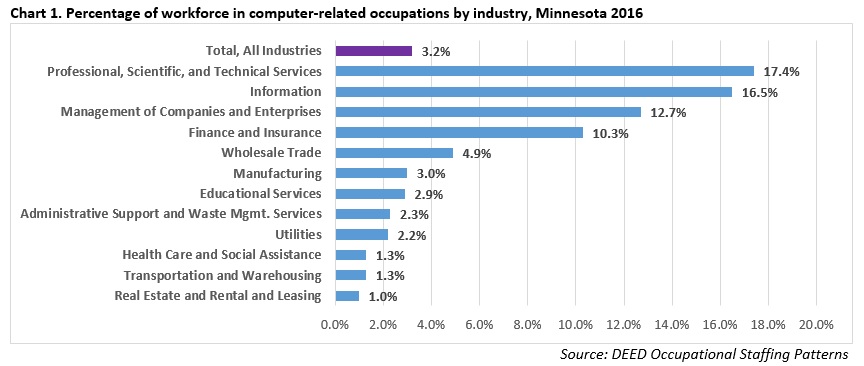 The presence of such industry powerhouses as Polaris, Arctic Cat and New Flyer make Northwest Minnesota a hub of transportation equipment manufacturing.
The presence of such industry powerhouses as Polaris, Arctic Cat and New Flyer make Northwest Minnesota a hub of transportation equipment manufacturing.
From wheat and potatoes to soybeans and sugar beets, the region is a major producer and processor of food staples and specialty agricultural products.
Want the freshest data delivered by email? Subscribe to our regional newsletters.
2/28/2017 12:04:56 PM
Chet Bodin
Broadband infrastructure continues to be a regular topic of discussion, particularly after DEED’s recent recommendation to the legislature that $100 million be allocated this year for the Border-to-Border Broadband grant program. Since 2014, this program has been a primary conduit for broadband development in rural Minnesota, funneling over $65 million across the state to encourage broadband investment in underserved areas eager to keep pace with the rapid increase in technological capacity.
The extent of technology advancement is illustrated by Moore’s Law, which would say that computing power has more than doubled since the Border-to-Border grant program was established! A blog from the Business Learning Institute points out “that computers today are about 130,000 times more powerful than they were in 1988,” meaning “that an iPad mini is as powerful as the world’s biggest supercomputer in 1985.” Broadband infrastructure is a key input that local businesses can use to unlock the growing value in communications, transactions and innovation that modern computing is creating.
Though gains have been made, there is still plenty of room for investment in broadband infrastructure in Northwest Minnesota. In last month’s Local Look blog, we speculated how investments might lead to more job growth in computer-related occupations. But this potential depends on how well education and workforce development programs build and align the skills that these future jobs will require. Modern computing is more user friendly than ever, and has the potential to make every worker more productive. But some industries will require more workers with computing skills to leverage Moore’s Law, and their leadership may drive local communities to make computing skills highly accessible, now and in the future.
For example, industries such as Professional, Scientific and Technical Services, Information, Management of Companies, and Finance and Insurance rely on computer programmers, network architects, and other computer-related occupations more than others. Chart 1 shows the industries in Minnesota that employ at least 1 percent of their workforce in computer-related occupations. On average, 3.2 percent of the Minnesota economy is composed of these type of jobs, and several industries, including those above and others that are very important to Northwest Minnesota, have a higher concentration of computer-related jobs. As of the second quarter of 2016, the industries in Chart 1 were responsible for over 57 percent of the employment in Northwest Minnesota.

Yet, computer-related occupations are just the most visible piece of the workforce challenge. Nearly every occupation in both rural and urban communities will be changed by the rapid infusion of technological capability. These changes have been witnessed by manufacturers who have seen their industry shrink, evolve, and regain momentum over the past 20 years. Likewise, technology is allowing medical professionals to provide services remotely, which will also benefit rural areas.
In addition to training more IT professionals, both public and private resources are needed to develop computer-related skills across the workforce. Tomorrow’s workforce will grow up learning these skills and will continue improving them throughout their lives. In December, DEED announced how state grants have been ensuring rural school districts, including several in Northwest Minnesota, have high-speed internet connections to complete homework and access other online learning opportunities. Linking education and training to workforce needs has always been a major goal of DEED and several other workforce and economic development institutions.
Interestingly, no matter how fast technology evolves or how these services are delivered, the fusion of education and industry needs will remain as important tomorrow as they were a century ago, perhaps even more so. Enhanced access to technology available through broadband investment will allow students and workers to develop and deploy computer-related skills throughout their lives. If modern computing continues to follow Moore’s Law, Northwest Minnesota will need access to such lifelong learning to maintain an adaptive and competitive workforce.
Chet Bodin
Regional Labor Market Analyst
Northwest Minnesota
chet.bodin@state.mn.us